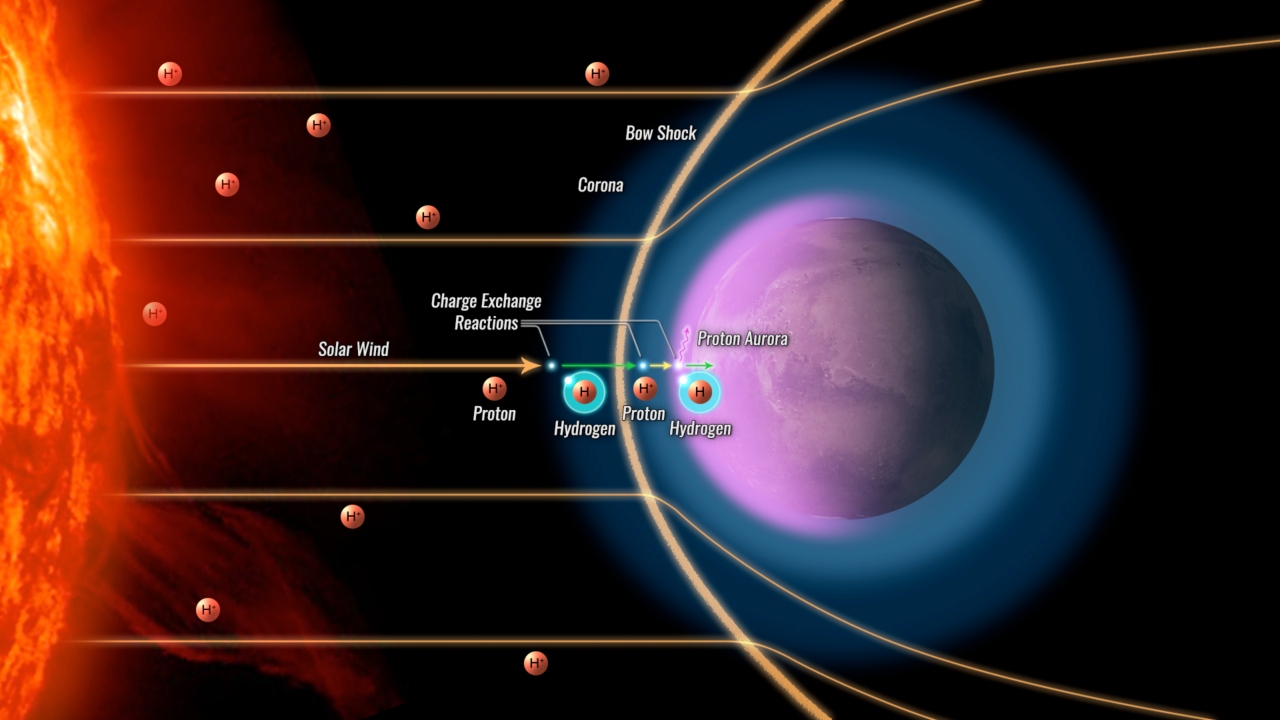Auroras, sometimes called polar lights, northern lights or southern lights, are ghostly displays of colourful light in the Earth’s night sky. These spectacular events, which are seen predominantly in the high-latitude regions near the poles, have featured at least as PC desktop backgrounds for everyone at some point in time. Now, as it turns out, Earth isn’t the only planet that witnesses the natural electrical phenomenon.
NASA’s MAVEN (Mars Atmosphere and Volatile Evolution mission) spacecraft just reported a new type of Martian aurora that occurs over much of the day side of the Red Planet, where auroras are very difficult to see. [caption id=“attachment_4804611” align=“alignnone” width=“1280”] First, a solar wind proton approaches Mars at high speed and encounters a cloud of hydrogen surrounding the planet. The proton steals an electron from a Martian hydrogen atom, thereby becoming a neutral atom. The atom passes through the bow shock, a magnetic obstacle surrounding Mars because neutral particles are not affected by magnetic fields. Finally, the hydrogen atom enters Mars’ atmosphere and collides with gas molecules, causing the atom to emit ultraviolet light. Image courtesy: NASA[/caption] “Auroras flare up when energetic particles plunge into a planet’s atmosphere, bombarding gases and making them glow. While electrons generally cause this natural phenomenon, sometime protons can elicit the same response, although it’s rarer. Now, the MAVEN team has learned that protons were doing at Mars the same thing as electrons usually do at Earth — create aurora,” a NASA statement said. NASA’s MAVEN team observed that on occasion, the ultraviolet light coming from hydrogen gas in Mars’ upper atmosphere would mysteriously and suddenly brighten for a few hours. Then, it was seen that the brightening events occurred when a MAVEN instrument, the Solar Wind Ion Analyser (SWIA), measured enhanced solar wind protons. What does that mean, you ask? A solar wind is an erratic flow of protons that the Sun ejects at speeds of over 3 million kilometres per hour. These protons are essentially hydrogen atoms stripped of their lone electrons by intense heat (check the illustration above for the detailed process). But this is where scientists encountered two major puzzles,
according to NASA: How did these protons get past the planet’s ‘bow shock’ — a magnetic obstacle which diverts the solar wind’s charged particles around the planet? And how could the protons give off a light, since atoms need electrons to do so? “The answer was thievery,” said Justin Deighan,
lead author of a paper on this research appearing 23 July in Nature Astronomy. “As they approach Mars, the protons coming in with the solar wind transform into neutral atoms by stealing electrons from the outer edge of the huge cloud of hydrogen surrounding the planet. The bow shock can only divert charged particles, so these neutral atoms continue right on through.”
When those high-speed incoming atoms hit Mars’ atmosphere, some of their energy was emitted as ultraviolet (UV) light, which is invisible to the human eye but detectable to instruments on MAVEN. In fact, one incoming atom can collide with molecules in the atmosphere hundreds of times before it slows down, giving off a slew of ultraviolet photons, NASA said. “The Martian proton auroras are more than a light show,” NASA quoted Jasper Halekas of the University of Iowa as saying. “They reveal that the solar wind is not completely diverted around Mars, by showing how solar wind protons can sneak past the bow shock and impact the atmosphere, depositing energy and even enhancing the hydrogen content there.”


)
)
)
)
)
)
)
)
)



